Business Economics Report
VerifiedAdded on 2020/07/23
|12
|3977
|57
Report
AI Summary
This report delves into various aspects of business economics, focusing on the UK economy. It covers topics such as the economic problem of scarcity, the role of demand and supply, market systems, opportunity costs, and elasticity. The report also analyzes the impact of pricing, market structure, and regulations on organizations like ALDI. Additionally, it evaluates macroeconomic policies and their effects on economic performance in a global context, concluding with insights on competitive advantages and the implications of free trade.
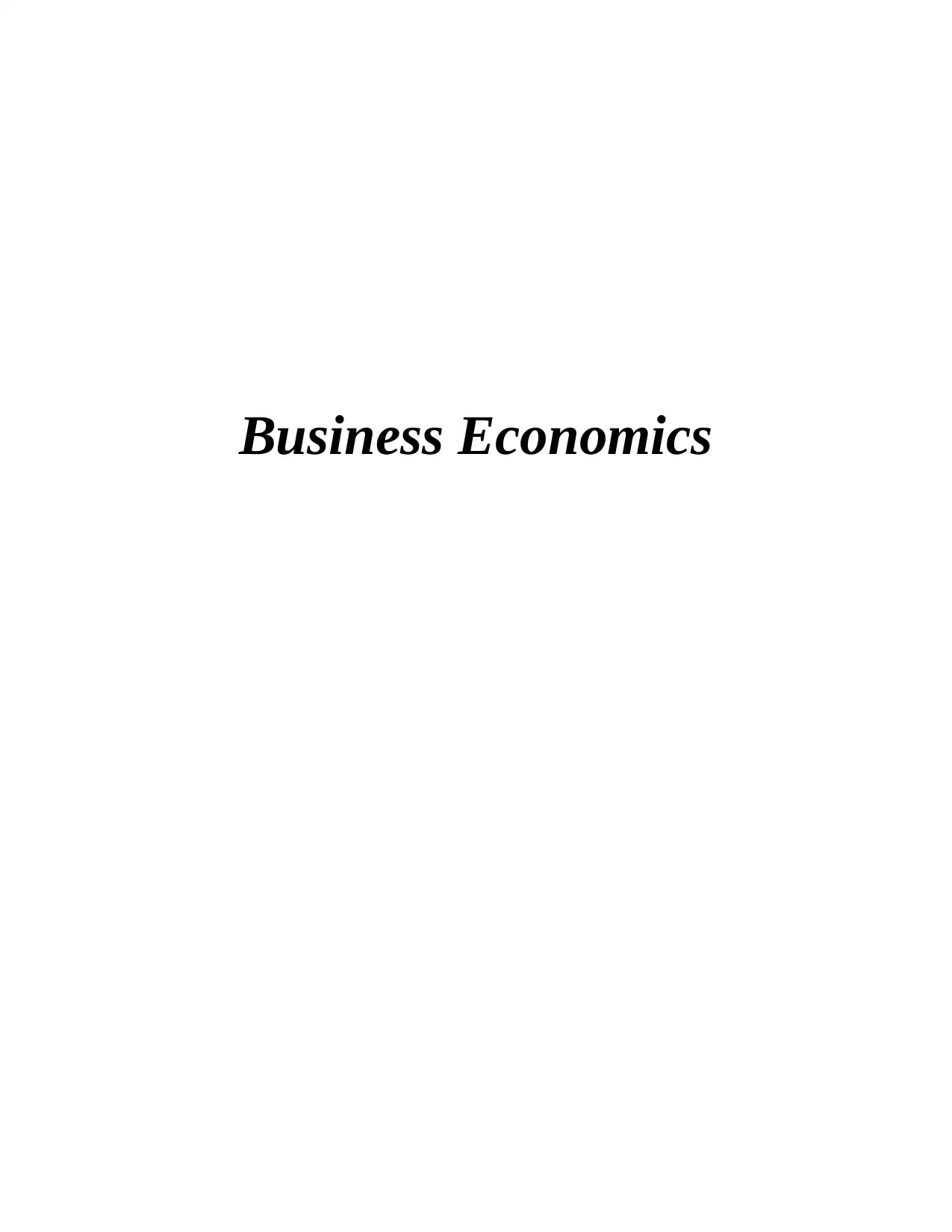
Business Economics
Paraphrase This Document
Need a fresh take? Get an instant paraphrase of this document with our AI Paraphraser
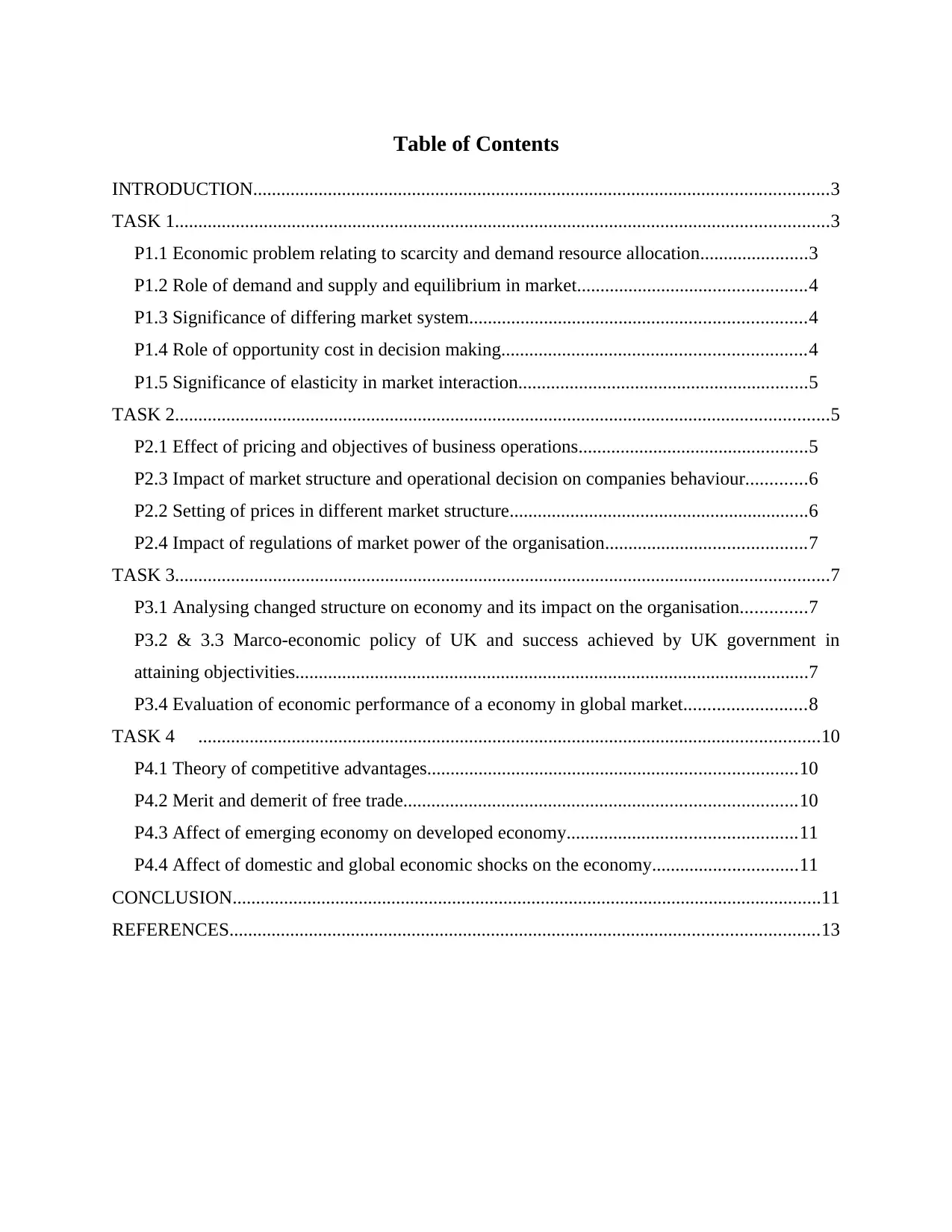
Table of Contents
INTRODUCTION...........................................................................................................................3
TASK 1............................................................................................................................................3
P1.1 Economic problem relating to scarcity and demand resource allocation.......................3
P1.2 Role of demand and supply and equilibrium in market.................................................4
P1.3 Significance of differing market system........................................................................4
P1.4 Role of opportunity cost in decision making.................................................................4
P1.5 Significance of elasticity in market interaction..............................................................5
TASK 2............................................................................................................................................5
P2.1 Effect of pricing and objectives of business operations.................................................5
P2.3 Impact of market structure and operational decision on companies behaviour.............6
P2.2 Setting of prices in different market structure................................................................6
P2.4 Impact of regulations of market power of the organisation...........................................7
TASK 3............................................................................................................................................7
P3.1 Analysing changed structure on economy and its impact on the organisation..............7
P3.2 & 3.3 Marco-economic policy of UK and success achieved by UK government in
attaining objectivities..............................................................................................................7
P3.4 Evaluation of economic performance of a economy in global market..........................8
TASK 4 .....................................................................................................................................10
P4.1 Theory of competitive advantages...............................................................................10
P4.2 Merit and demerit of free trade....................................................................................10
P4.3 Affect of emerging economy on developed economy.................................................11
P4.4 Affect of domestic and global economic shocks on the economy...............................11
CONCLUSION..............................................................................................................................11
REFERENCES..............................................................................................................................13
INTRODUCTION...........................................................................................................................3
TASK 1............................................................................................................................................3
P1.1 Economic problem relating to scarcity and demand resource allocation.......................3
P1.2 Role of demand and supply and equilibrium in market.................................................4
P1.3 Significance of differing market system........................................................................4
P1.4 Role of opportunity cost in decision making.................................................................4
P1.5 Significance of elasticity in market interaction..............................................................5
TASK 2............................................................................................................................................5
P2.1 Effect of pricing and objectives of business operations.................................................5
P2.3 Impact of market structure and operational decision on companies behaviour.............6
P2.2 Setting of prices in different market structure................................................................6
P2.4 Impact of regulations of market power of the organisation...........................................7
TASK 3............................................................................................................................................7
P3.1 Analysing changed structure on economy and its impact on the organisation..............7
P3.2 & 3.3 Marco-economic policy of UK and success achieved by UK government in
attaining objectivities..............................................................................................................7
P3.4 Evaluation of economic performance of a economy in global market..........................8
TASK 4 .....................................................................................................................................10
P4.1 Theory of competitive advantages...............................................................................10
P4.2 Merit and demerit of free trade....................................................................................10
P4.3 Affect of emerging economy on developed economy.................................................11
P4.4 Affect of domestic and global economic shocks on the economy...............................11
CONCLUSION..............................................................................................................................11
REFERENCES..............................................................................................................................13

INTRODUCTION
Economics deals with services and good production in he specific nation's economy. This
also undertake the process of consumption and distribution etc. As market is dynamic and
economic rely on market for decision making, this is very essential to understand and analyse the
external factor of business. The United Kingdom is one of the developed nation in entire globe
holding a better place among hundreds of nations. Currency of the nation is Pound Sterling
which has more value in comparison of Dollar along with 1,396.90EUR minimum wage of
people each month (Audretsch, Kuratko and Link, 2015). The GDP of country is 2.219 trillion as
well as 39,899.30USD per capita. In the recent UK scenario, the country is facing various down
and reduce in commodities demands. The report will understand microeconomic theory, impact
of market power on UK economy as well as role of government in macro environment in UK.
TASK 1
P1.1 Economic problem relating to scarcity and demand resource allocation
After the recession and crisis period, although UK have controlled their inflation rates but
the issue of resource scarcity may drive high cost in the nation. The major reason behind entire
raised value scenario of commodities is that the supply does not get raised within a span of time
but its demands in enlarging amount the expectation of supplier and capacity of manufacture.
Each economy contains limited resource in which allocation become the major issues, for
example, the state of United Kingdom may desire to invest their resource of finance in the
employment of people but at the same time, they have to work on saving funds and capital for
managing conflicts and predictable conflicts that can take fire in future due to Brexit period. For
example, if any retaining company like ALDI increase their rates, increment in inflation rate will
took place (Microeconomics, 2017.). After unable to accomplish demand cause of scarcity of
resource of raw material, it has affect ALDI business negatively.
P1.2 Role of demand and supply and equilibrium in market
Desire of buying a product is called demand but this is essential to understand some facts
before discussing it i.e. if a person have long for products but do not have proper financial
resource to make a purchase, this would not be considered as “demand”. Supply whereas linked
with the foods availability in market (Williams, 2015). This is impossible to stand on economic
situation in absence of link between demands and supply. This is major aspects of business of
Economics deals with services and good production in he specific nation's economy. This
also undertake the process of consumption and distribution etc. As market is dynamic and
economic rely on market for decision making, this is very essential to understand and analyse the
external factor of business. The United Kingdom is one of the developed nation in entire globe
holding a better place among hundreds of nations. Currency of the nation is Pound Sterling
which has more value in comparison of Dollar along with 1,396.90EUR minimum wage of
people each month (Audretsch, Kuratko and Link, 2015). The GDP of country is 2.219 trillion as
well as 39,899.30USD per capita. In the recent UK scenario, the country is facing various down
and reduce in commodities demands. The report will understand microeconomic theory, impact
of market power on UK economy as well as role of government in macro environment in UK.
TASK 1
P1.1 Economic problem relating to scarcity and demand resource allocation
After the recession and crisis period, although UK have controlled their inflation rates but
the issue of resource scarcity may drive high cost in the nation. The major reason behind entire
raised value scenario of commodities is that the supply does not get raised within a span of time
but its demands in enlarging amount the expectation of supplier and capacity of manufacture.
Each economy contains limited resource in which allocation become the major issues, for
example, the state of United Kingdom may desire to invest their resource of finance in the
employment of people but at the same time, they have to work on saving funds and capital for
managing conflicts and predictable conflicts that can take fire in future due to Brexit period. For
example, if any retaining company like ALDI increase their rates, increment in inflation rate will
took place (Microeconomics, 2017.). After unable to accomplish demand cause of scarcity of
resource of raw material, it has affect ALDI business negatively.
P1.2 Role of demand and supply and equilibrium in market
Desire of buying a product is called demand but this is essential to understand some facts
before discussing it i.e. if a person have long for products but do not have proper financial
resource to make a purchase, this would not be considered as “demand”. Supply whereas linked
with the foods availability in market (Williams, 2015). This is impossible to stand on economic
situation in absence of link between demands and supply. This is major aspects of business of
⊘ This is a preview!⊘
Do you want full access?
Subscribe today to unlock all pages.

Trusted by 1+ million students worldwide
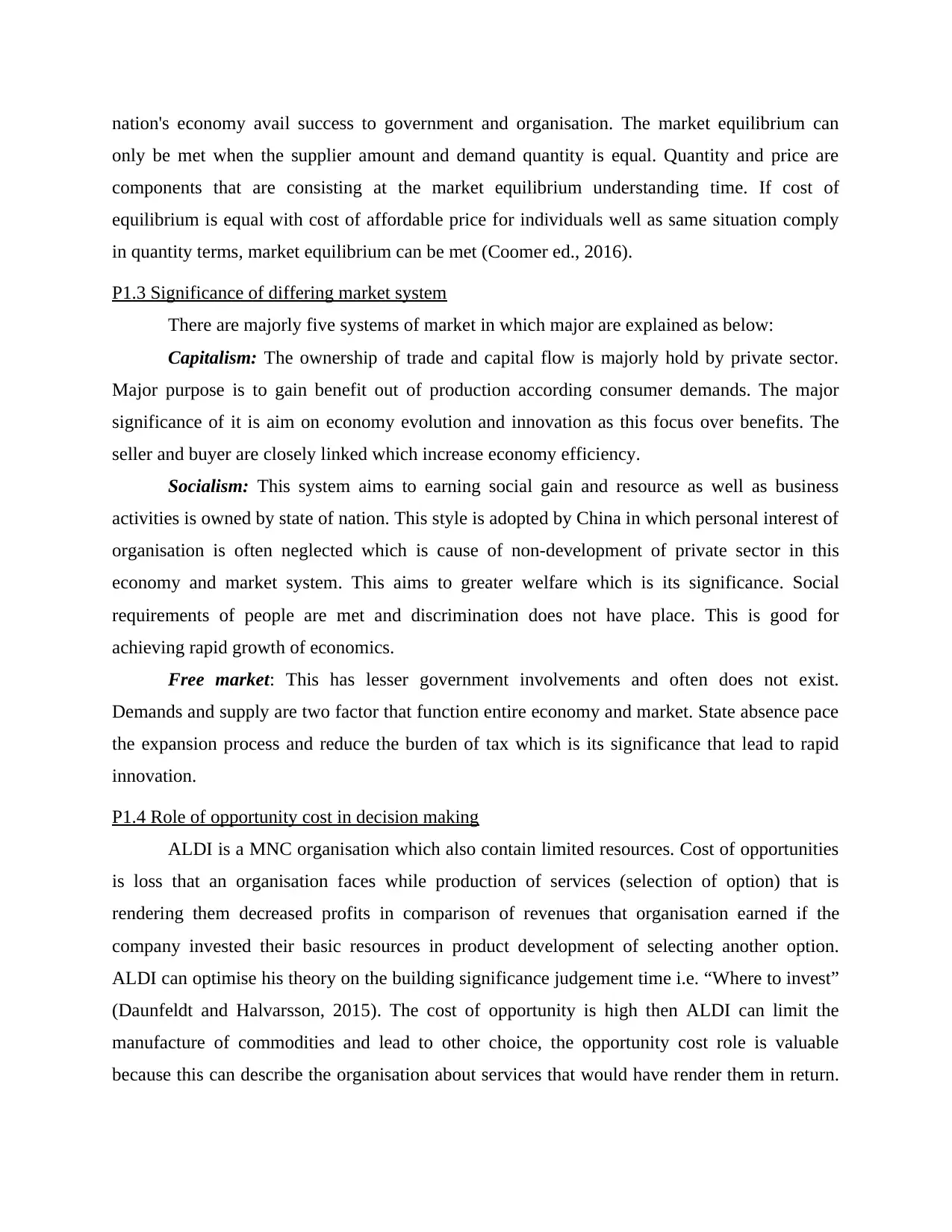
nation's economy avail success to government and organisation. The market equilibrium can
only be met when the supplier amount and demand quantity is equal. Quantity and price are
components that are consisting at the market equilibrium understanding time. If cost of
equilibrium is equal with cost of affordable price for individuals well as same situation comply
in quantity terms, market equilibrium can be met (Coomer ed., 2016).
P1.3 Significance of differing market system
There are majorly five systems of market in which major are explained as below:
Capitalism: The ownership of trade and capital flow is majorly hold by private sector.
Major purpose is to gain benefit out of production according consumer demands. The major
significance of it is aim on economy evolution and innovation as this focus over benefits. The
seller and buyer are closely linked which increase economy efficiency.
Socialism: This system aims to earning social gain and resource as well as business
activities is owned by state of nation. This style is adopted by China in which personal interest of
organisation is often neglected which is cause of non-development of private sector in this
economy and market system. This aims to greater welfare which is its significance. Social
requirements of people are met and discrimination does not have place. This is good for
achieving rapid growth of economics.
Free market: This has lesser government involvements and often does not exist.
Demands and supply are two factor that function entire economy and market. State absence pace
the expansion process and reduce the burden of tax which is its significance that lead to rapid
innovation.
P1.4 Role of opportunity cost in decision making
ALDI is a MNC organisation which also contain limited resources. Cost of opportunities
is loss that an organisation faces while production of services (selection of option) that is
rendering them decreased profits in comparison of revenues that organisation earned if the
company invested their basic resources in product development of selecting another option.
ALDI can optimise his theory on the building significance judgement time i.e. “Where to invest”
(Daunfeldt and Halvarsson, 2015). The cost of opportunity is high then ALDI can limit the
manufacture of commodities and lead to other choice, the opportunity cost role is valuable
because this can describe the organisation about services that would have render them in return.
only be met when the supplier amount and demand quantity is equal. Quantity and price are
components that are consisting at the market equilibrium understanding time. If cost of
equilibrium is equal with cost of affordable price for individuals well as same situation comply
in quantity terms, market equilibrium can be met (Coomer ed., 2016).
P1.3 Significance of differing market system
There are majorly five systems of market in which major are explained as below:
Capitalism: The ownership of trade and capital flow is majorly hold by private sector.
Major purpose is to gain benefit out of production according consumer demands. The major
significance of it is aim on economy evolution and innovation as this focus over benefits. The
seller and buyer are closely linked which increase economy efficiency.
Socialism: This system aims to earning social gain and resource as well as business
activities is owned by state of nation. This style is adopted by China in which personal interest of
organisation is often neglected which is cause of non-development of private sector in this
economy and market system. This aims to greater welfare which is its significance. Social
requirements of people are met and discrimination does not have place. This is good for
achieving rapid growth of economics.
Free market: This has lesser government involvements and often does not exist.
Demands and supply are two factor that function entire economy and market. State absence pace
the expansion process and reduce the burden of tax which is its significance that lead to rapid
innovation.
P1.4 Role of opportunity cost in decision making
ALDI is a MNC organisation which also contain limited resources. Cost of opportunities
is loss that an organisation faces while production of services (selection of option) that is
rendering them decreased profits in comparison of revenues that organisation earned if the
company invested their basic resources in product development of selecting another option.
ALDI can optimise his theory on the building significance judgement time i.e. “Where to invest”
(Daunfeldt and Halvarsson, 2015). The cost of opportunity is high then ALDI can limit the
manufacture of commodities and lead to other choice, the opportunity cost role is valuable
because this can describe the organisation about services that would have render them in return.
Paraphrase This Document
Need a fresh take? Get an instant paraphrase of this document with our AI Paraphraser

At the future strategy building time, the company can understand these elements. The role of this
is fundamental in the planning and decision-making process.
P1.5 Significance of elasticity in market interaction
The demand elasticity is linked with demand changes that occurs cause of other essential
product elements like food cost etc. If the elasticity demand is higher, then it refers to active
response of consumer towards alternation. ALDI is merchandising a wide product range in
market. Like if butter cost get gain, then according to concept of demand, demands will fall for a
while. It is useful concept for multinational organisation like ALDI in gaining expected sales and
fixing some aspects for future purpose. Such companies deal with hundreds of products which
make the management process more complex for them. Another value is it avail in price
determination process of company. For example, ALDI can raise their cost of their luxury or
other products after the people's per capita income increase. In this case, people agree with more
payment of more money to get enhanced quality.
TASK 2
P2.1 Effect of pricing and objectives of business operations
Impact of corporate objectives and costing on ALDI's operations:
Enhanced Benefits: The company know the nation's economic growth is slower and
people prefer more necessary thing and affordable product purchase. Despite of luxurious
products sale, organisations have merchandising affordable products (Ghio and et. al., 2015 ).
The focus is to get high spot in UK retailing sector as well as appropriate costing can aid them in
functioning forward to meet the objectives of business.
Worker's Efficiency Increment: One of corporation's major objectives is worker's
welfare. The company consider them as the main assets that helps in development for which they
organise training and development programs for enlarging their knowledge. This helps in job
satisfaction and creating a goodwill of enterprise. ALDI's productivity have seen likely
alternation and output have increased.
P2.3 Impact of market structure and operational decision on companies behaviour
ALDI is functioning monopolistic structure of market. The organisation believes in
delivering the better product quality to their consumer by some of their rivals or small companies
are rendering same item in lower cost for charging better money or revenues, But these
is fundamental in the planning and decision-making process.
P1.5 Significance of elasticity in market interaction
The demand elasticity is linked with demand changes that occurs cause of other essential
product elements like food cost etc. If the elasticity demand is higher, then it refers to active
response of consumer towards alternation. ALDI is merchandising a wide product range in
market. Like if butter cost get gain, then according to concept of demand, demands will fall for a
while. It is useful concept for multinational organisation like ALDI in gaining expected sales and
fixing some aspects for future purpose. Such companies deal with hundreds of products which
make the management process more complex for them. Another value is it avail in price
determination process of company. For example, ALDI can raise their cost of their luxury or
other products after the people's per capita income increase. In this case, people agree with more
payment of more money to get enhanced quality.
TASK 2
P2.1 Effect of pricing and objectives of business operations
Impact of corporate objectives and costing on ALDI's operations:
Enhanced Benefits: The company know the nation's economic growth is slower and
people prefer more necessary thing and affordable product purchase. Despite of luxurious
products sale, organisations have merchandising affordable products (Ghio and et. al., 2015 ).
The focus is to get high spot in UK retailing sector as well as appropriate costing can aid them in
functioning forward to meet the objectives of business.
Worker's Efficiency Increment: One of corporation's major objectives is worker's
welfare. The company consider them as the main assets that helps in development for which they
organise training and development programs for enlarging their knowledge. This helps in job
satisfaction and creating a goodwill of enterprise. ALDI's productivity have seen likely
alternation and output have increased.
P2.3 Impact of market structure and operational decision on companies behaviour
ALDI is functioning monopolistic structure of market. The organisation believes in
delivering the better product quality to their consumer by some of their rivals or small companies
are rendering same item in lower cost for charging better money or revenues, But these
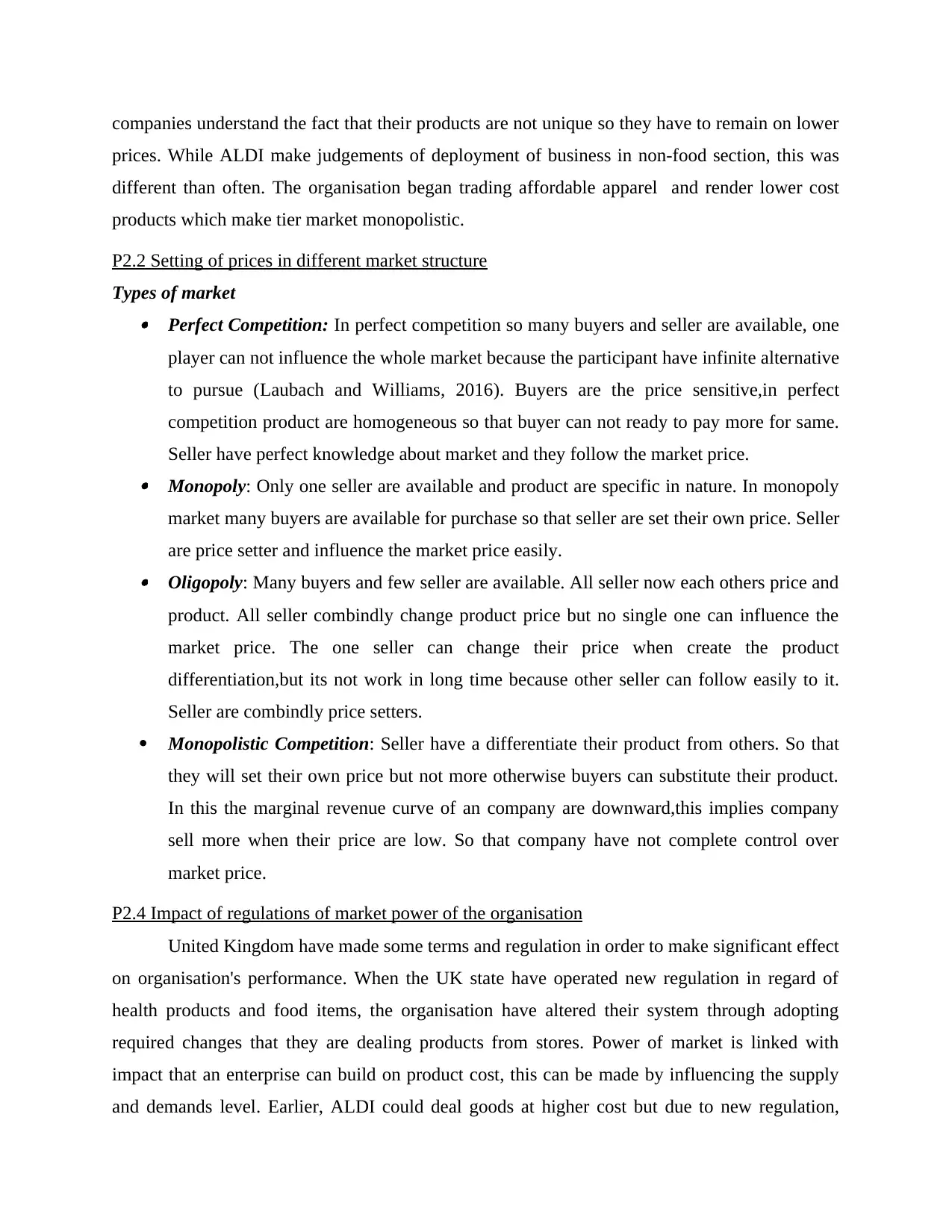
companies understand the fact that their products are not unique so they have to remain on lower
prices. While ALDI make judgements of deployment of business in non-food section, this was
different than often. The organisation began trading affordable apparel and render lower cost
products which make tier market monopolistic.
P2.2 Setting of prices in different market structure
Types of market Perfect Competition: In perfect competition so many buyers and seller are available, one
player can not influence the whole market because the participant have infinite alternative
to pursue (Laubach and Williams, 2016). Buyers are the price sensitive,in perfect
competition product are homogeneous so that buyer can not ready to pay more for same.
Seller have perfect knowledge about market and they follow the market price. Monopoly: Only one seller are available and product are specific in nature. In monopoly
market many buyers are available for purchase so that seller are set their own price. Seller
are price setter and influence the market price easily. Oligopoly: Many buyers and few seller are available. All seller now each others price and
product. All seller combindly change product price but no single one can influence the
market price. The one seller can change their price when create the product
differentiation,but its not work in long time because other seller can follow easily to it.
Seller are combindly price setters.
Monopolistic Competition: Seller have a differentiate their product from others. So that
they will set their own price but not more otherwise buyers can substitute their product.
In this the marginal revenue curve of an company are downward,this implies company
sell more when their price are low. So that company have not complete control over
market price.
P2.4 Impact of regulations of market power of the organisation
United Kingdom have made some terms and regulation in order to make significant effect
on organisation's performance. When the UK state have operated new regulation in regard of
health products and food items, the organisation have altered their system through adopting
required changes that they are dealing products from stores. Power of market is linked with
impact that an enterprise can build on product cost, this can be made by influencing the supply
and demands level. Earlier, ALDI could deal goods at higher cost but due to new regulation,
prices. While ALDI make judgements of deployment of business in non-food section, this was
different than often. The organisation began trading affordable apparel and render lower cost
products which make tier market monopolistic.
P2.2 Setting of prices in different market structure
Types of market Perfect Competition: In perfect competition so many buyers and seller are available, one
player can not influence the whole market because the participant have infinite alternative
to pursue (Laubach and Williams, 2016). Buyers are the price sensitive,in perfect
competition product are homogeneous so that buyer can not ready to pay more for same.
Seller have perfect knowledge about market and they follow the market price. Monopoly: Only one seller are available and product are specific in nature. In monopoly
market many buyers are available for purchase so that seller are set their own price. Seller
are price setter and influence the market price easily. Oligopoly: Many buyers and few seller are available. All seller now each others price and
product. All seller combindly change product price but no single one can influence the
market price. The one seller can change their price when create the product
differentiation,but its not work in long time because other seller can follow easily to it.
Seller are combindly price setters.
Monopolistic Competition: Seller have a differentiate their product from others. So that
they will set their own price but not more otherwise buyers can substitute their product.
In this the marginal revenue curve of an company are downward,this implies company
sell more when their price are low. So that company have not complete control over
market price.
P2.4 Impact of regulations of market power of the organisation
United Kingdom have made some terms and regulation in order to make significant effect
on organisation's performance. When the UK state have operated new regulation in regard of
health products and food items, the organisation have altered their system through adopting
required changes that they are dealing products from stores. Power of market is linked with
impact that an enterprise can build on product cost, this can be made by influencing the supply
and demands level. Earlier, ALDI could deal goods at higher cost but due to new regulation,
⊘ This is a preview!⊘
Do you want full access?
Subscribe today to unlock all pages.

Trusted by 1+ million students worldwide
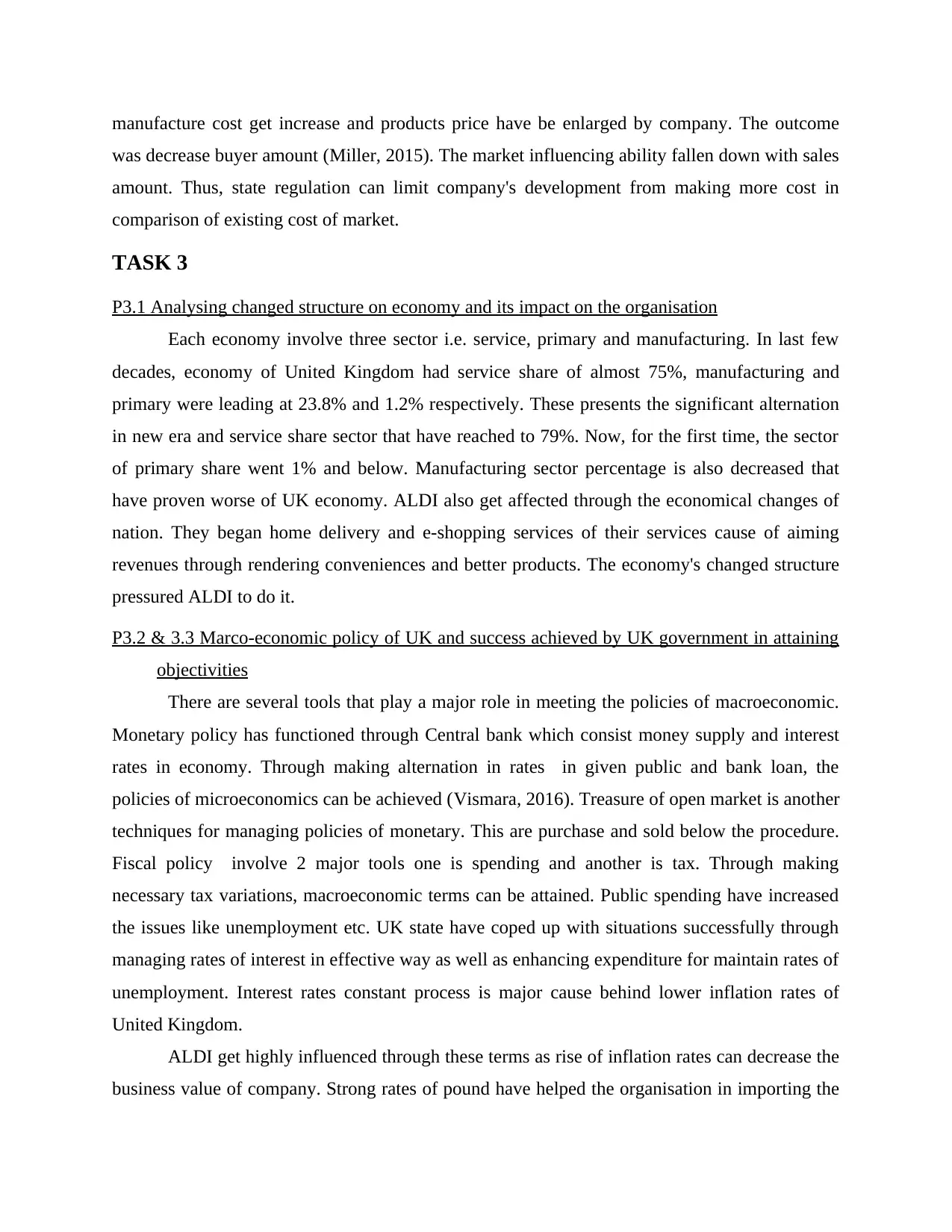
manufacture cost get increase and products price have be enlarged by company. The outcome
was decrease buyer amount (Miller, 2015). The market influencing ability fallen down with sales
amount. Thus, state regulation can limit company's development from making more cost in
comparison of existing cost of market.
TASK 3
P3.1 Analysing changed structure on economy and its impact on the organisation
Each economy involve three sector i.e. service, primary and manufacturing. In last few
decades, economy of United Kingdom had service share of almost 75%, manufacturing and
primary were leading at 23.8% and 1.2% respectively. These presents the significant alternation
in new era and service share sector that have reached to 79%. Now, for the first time, the sector
of primary share went 1% and below. Manufacturing sector percentage is also decreased that
have proven worse of UK economy. ALDI also get affected through the economical changes of
nation. They began home delivery and e-shopping services of their services cause of aiming
revenues through rendering conveniences and better products. The economy's changed structure
pressured ALDI to do it.
P3.2 & 3.3 Marco-economic policy of UK and success achieved by UK government in attaining
objectivities
There are several tools that play a major role in meeting the policies of macroeconomic.
Monetary policy has functioned through Central bank which consist money supply and interest
rates in economy. Through making alternation in rates in given public and bank loan, the
policies of microeconomics can be achieved (Vismara, 2016). Treasure of open market is another
techniques for managing policies of monetary. This are purchase and sold below the procedure.
Fiscal policy involve 2 major tools one is spending and another is tax. Through making
necessary tax variations, macroeconomic terms can be attained. Public spending have increased
the issues like unemployment etc. UK state have coped up with situations successfully through
managing rates of interest in effective way as well as enhancing expenditure for maintain rates of
unemployment. Interest rates constant process is major cause behind lower inflation rates of
United Kingdom.
ALDI get highly influenced through these terms as rise of inflation rates can decrease the
business value of company. Strong rates of pound have helped the organisation in importing the
was decrease buyer amount (Miller, 2015). The market influencing ability fallen down with sales
amount. Thus, state regulation can limit company's development from making more cost in
comparison of existing cost of market.
TASK 3
P3.1 Analysing changed structure on economy and its impact on the organisation
Each economy involve three sector i.e. service, primary and manufacturing. In last few
decades, economy of United Kingdom had service share of almost 75%, manufacturing and
primary were leading at 23.8% and 1.2% respectively. These presents the significant alternation
in new era and service share sector that have reached to 79%. Now, for the first time, the sector
of primary share went 1% and below. Manufacturing sector percentage is also decreased that
have proven worse of UK economy. ALDI also get affected through the economical changes of
nation. They began home delivery and e-shopping services of their services cause of aiming
revenues through rendering conveniences and better products. The economy's changed structure
pressured ALDI to do it.
P3.2 & 3.3 Marco-economic policy of UK and success achieved by UK government in attaining
objectivities
There are several tools that play a major role in meeting the policies of macroeconomic.
Monetary policy has functioned through Central bank which consist money supply and interest
rates in economy. Through making alternation in rates in given public and bank loan, the
policies of microeconomics can be achieved (Vismara, 2016). Treasure of open market is another
techniques for managing policies of monetary. This are purchase and sold below the procedure.
Fiscal policy involve 2 major tools one is spending and another is tax. Through making
necessary tax variations, macroeconomic terms can be attained. Public spending have increased
the issues like unemployment etc. UK state have coped up with situations successfully through
managing rates of interest in effective way as well as enhancing expenditure for maintain rates of
unemployment. Interest rates constant process is major cause behind lower inflation rates of
United Kingdom.
ALDI get highly influenced through these terms as rise of inflation rates can decrease the
business value of company. Strong rates of pound have helped the organisation in importing the
Paraphrase This Document
Need a fresh take? Get an instant paraphrase of this document with our AI Paraphraser
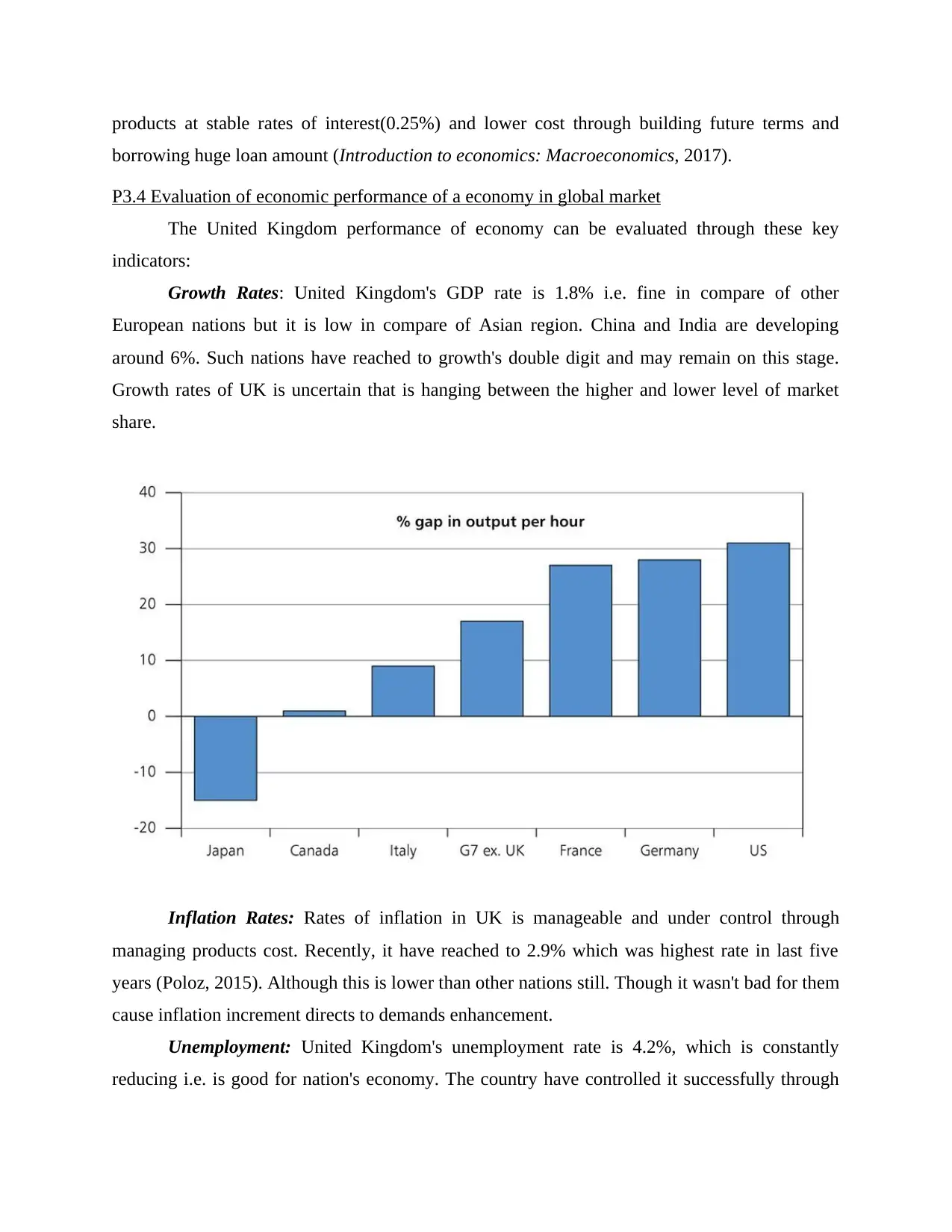
products at stable rates of interest(0.25%) and lower cost through building future terms and
borrowing huge loan amount (Introduction to economics: Macroeconomics, 2017).
P3.4 Evaluation of economic performance of a economy in global market
The United Kingdom performance of economy can be evaluated through these key
indicators:
Growth Rates: United Kingdom's GDP rate is 1.8% i.e. fine in compare of other
European nations but it is low in compare of Asian region. China and India are developing
around 6%. Such nations have reached to growth's double digit and may remain on this stage.
Growth rates of UK is uncertain that is hanging between the higher and lower level of market
share.
Inflation Rates: Rates of inflation in UK is manageable and under control through
managing products cost. Recently, it have reached to 2.9% which was highest rate in last five
years (Poloz, 2015). Although this is lower than other nations still. Though it wasn't bad for them
cause inflation increment directs to demands enhancement.
Unemployment: United Kingdom's unemployment rate is 4.2%, which is constantly
reducing i.e. is good for nation's economy. The country have controlled it successfully through
borrowing huge loan amount (Introduction to economics: Macroeconomics, 2017).
P3.4 Evaluation of economic performance of a economy in global market
The United Kingdom performance of economy can be evaluated through these key
indicators:
Growth Rates: United Kingdom's GDP rate is 1.8% i.e. fine in compare of other
European nations but it is low in compare of Asian region. China and India are developing
around 6%. Such nations have reached to growth's double digit and may remain on this stage.
Growth rates of UK is uncertain that is hanging between the higher and lower level of market
share.
Inflation Rates: Rates of inflation in UK is manageable and under control through
managing products cost. Recently, it have reached to 2.9% which was highest rate in last five
years (Poloz, 2015). Although this is lower than other nations still. Though it wasn't bad for them
cause inflation increment directs to demands enhancement.
Unemployment: United Kingdom's unemployment rate is 4.2%, which is constantly
reducing i.e. is good for nation's economy. The country have controlled it successfully through

remarkable process i.e. lower in compare of Germany with 3.7% unemployment but better than
USA. United Kingdom may face the unemployment rates decrease in future but this can be
managed due to their effective approaches and techniques which country have adopted while the
time of recession and crisis in country.
ALDI is influenced through United Kingdom's economy cause its business relay on their
market. Lower rates of growth of UK is major cause behind their enhanced inflation and slow
deployment decreasing the revenues rates.
TASK 4
P4.1 Theory of competitive advantages
There are several theories which is beneficial in the business competitive sector but the
theory given by David Ricardo is more effective. This theory argues that nations are meeting
competitive edge due to their lower cost of opportunities. Fr example, the Indian IT services is
available at lower rates which is lower in compare of UK. India IT organisation are developing at
higher in compare of UK because of their increase clients and strategy of low cost (Rivlin, 2015).
The services and products made by these companies of IT in United Kingdom's cots is higher as
well as labour cost is higher as well. UK economy is improved and most UK commodities are
available at high cost in compare of market in India. Whereas United Kingdom is facing such
situation of loss cause of their higher cost of IT system that is required to be manage within a
span of time in order to control the outcome as well as future hold of nations.
P4.2 Merit and demerit of free trade
Each nation has few benefits. If they are able to produce lower cost products then it
would beneficial for both nation who is importing and who is producing (Taylor and Wieland,
2016). The country can manufacture lower priced cloths, Cloth producing enterprises are earning
competitive edge cause of their thread availability at lower rates. Here are some merits and
demerits mentioned of free trade:
Benefits: One of major benefits of free trade is FDI. Organisation from various nations
like to set plants in UK for producing cloths. This produce a likely impact on
development of economy of nation and domestic parts. Business dynamic climate deliver
another merit of free trade. This deliver economy stability.
USA. United Kingdom may face the unemployment rates decrease in future but this can be
managed due to their effective approaches and techniques which country have adopted while the
time of recession and crisis in country.
ALDI is influenced through United Kingdom's economy cause its business relay on their
market. Lower rates of growth of UK is major cause behind their enhanced inflation and slow
deployment decreasing the revenues rates.
TASK 4
P4.1 Theory of competitive advantages
There are several theories which is beneficial in the business competitive sector but the
theory given by David Ricardo is more effective. This theory argues that nations are meeting
competitive edge due to their lower cost of opportunities. Fr example, the Indian IT services is
available at lower rates which is lower in compare of UK. India IT organisation are developing at
higher in compare of UK because of their increase clients and strategy of low cost (Rivlin, 2015).
The services and products made by these companies of IT in United Kingdom's cots is higher as
well as labour cost is higher as well. UK economy is improved and most UK commodities are
available at high cost in compare of market in India. Whereas United Kingdom is facing such
situation of loss cause of their higher cost of IT system that is required to be manage within a
span of time in order to control the outcome as well as future hold of nations.
P4.2 Merit and demerit of free trade
Each nation has few benefits. If they are able to produce lower cost products then it
would beneficial for both nation who is importing and who is producing (Taylor and Wieland,
2016). The country can manufacture lower priced cloths, Cloth producing enterprises are earning
competitive edge cause of their thread availability at lower rates. Here are some merits and
demerits mentioned of free trade:
Benefits: One of major benefits of free trade is FDI. Organisation from various nations
like to set plants in UK for producing cloths. This produce a likely impact on
development of economy of nation and domestic parts. Business dynamic climate deliver
another merit of free trade. This deliver economy stability.
⊘ This is a preview!⊘
Do you want full access?
Subscribe today to unlock all pages.

Trusted by 1+ million students worldwide
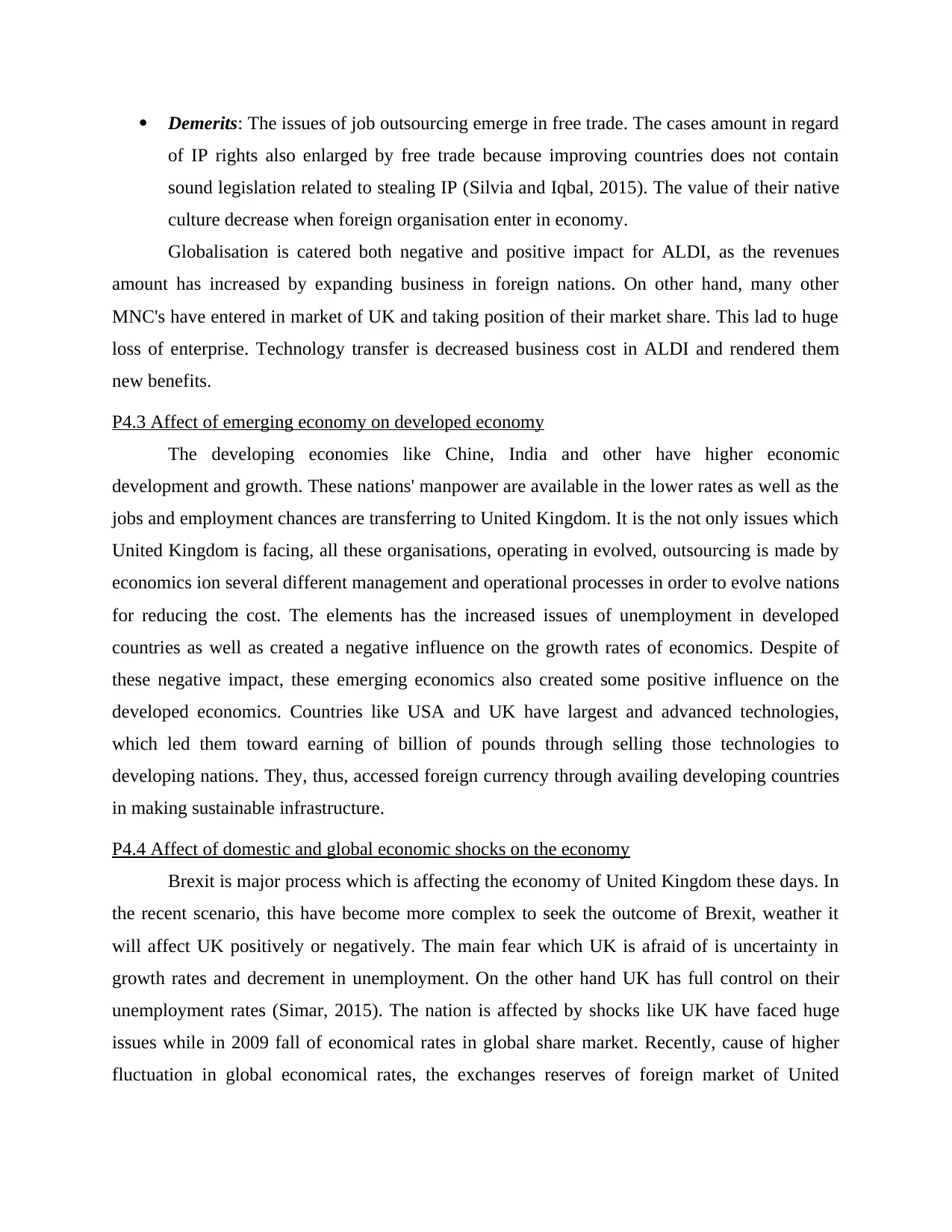
Demerits: The issues of job outsourcing emerge in free trade. The cases amount in regard
of IP rights also enlarged by free trade because improving countries does not contain
sound legislation related to stealing IP (Silvia and Iqbal, 2015). The value of their native
culture decrease when foreign organisation enter in economy.
Globalisation is catered both negative and positive impact for ALDI, as the revenues
amount has increased by expanding business in foreign nations. On other hand, many other
MNC's have entered in market of UK and taking position of their market share. This lad to huge
loss of enterprise. Technology transfer is decreased business cost in ALDI and rendered them
new benefits.
P4.3 Affect of emerging economy on developed economy
The developing economies like Chine, India and other have higher economic
development and growth. These nations' manpower are available in the lower rates as well as the
jobs and employment chances are transferring to United Kingdom. It is the not only issues which
United Kingdom is facing, all these organisations, operating in evolved, outsourcing is made by
economics ion several different management and operational processes in order to evolve nations
for reducing the cost. The elements has the increased issues of unemployment in developed
countries as well as created a negative influence on the growth rates of economics. Despite of
these negative impact, these emerging economics also created some positive influence on the
developed economics. Countries like USA and UK have largest and advanced technologies,
which led them toward earning of billion of pounds through selling those technologies to
developing nations. They, thus, accessed foreign currency through availing developing countries
in making sustainable infrastructure.
P4.4 Affect of domestic and global economic shocks on the economy
Brexit is major process which is affecting the economy of United Kingdom these days. In
the recent scenario, this have become more complex to seek the outcome of Brexit, weather it
will affect UK positively or negatively. The main fear which UK is afraid of is uncertainty in
growth rates and decrement in unemployment. On the other hand UK has full control on their
unemployment rates (Simar, 2015). The nation is affected by shocks like UK have faced huge
issues while in 2009 fall of economical rates in global share market. Recently, cause of higher
fluctuation in global economical rates, the exchanges reserves of foreign market of United
of IP rights also enlarged by free trade because improving countries does not contain
sound legislation related to stealing IP (Silvia and Iqbal, 2015). The value of their native
culture decrease when foreign organisation enter in economy.
Globalisation is catered both negative and positive impact for ALDI, as the revenues
amount has increased by expanding business in foreign nations. On other hand, many other
MNC's have entered in market of UK and taking position of their market share. This lad to huge
loss of enterprise. Technology transfer is decreased business cost in ALDI and rendered them
new benefits.
P4.3 Affect of emerging economy on developed economy
The developing economies like Chine, India and other have higher economic
development and growth. These nations' manpower are available in the lower rates as well as the
jobs and employment chances are transferring to United Kingdom. It is the not only issues which
United Kingdom is facing, all these organisations, operating in evolved, outsourcing is made by
economics ion several different management and operational processes in order to evolve nations
for reducing the cost. The elements has the increased issues of unemployment in developed
countries as well as created a negative influence on the growth rates of economics. Despite of
these negative impact, these emerging economics also created some positive influence on the
developed economics. Countries like USA and UK have largest and advanced technologies,
which led them toward earning of billion of pounds through selling those technologies to
developing nations. They, thus, accessed foreign currency through availing developing countries
in making sustainable infrastructure.
P4.4 Affect of domestic and global economic shocks on the economy
Brexit is major process which is affecting the economy of United Kingdom these days. In
the recent scenario, this have become more complex to seek the outcome of Brexit, weather it
will affect UK positively or negatively. The main fear which UK is afraid of is uncertainty in
growth rates and decrement in unemployment. On the other hand UK has full control on their
unemployment rates (Simar, 2015). The nation is affected by shocks like UK have faced huge
issues while in 2009 fall of economical rates in global share market. Recently, cause of higher
fluctuation in global economical rates, the exchanges reserves of foreign market of United
Paraphrase This Document
Need a fresh take? Get an instant paraphrase of this document with our AI Paraphraser
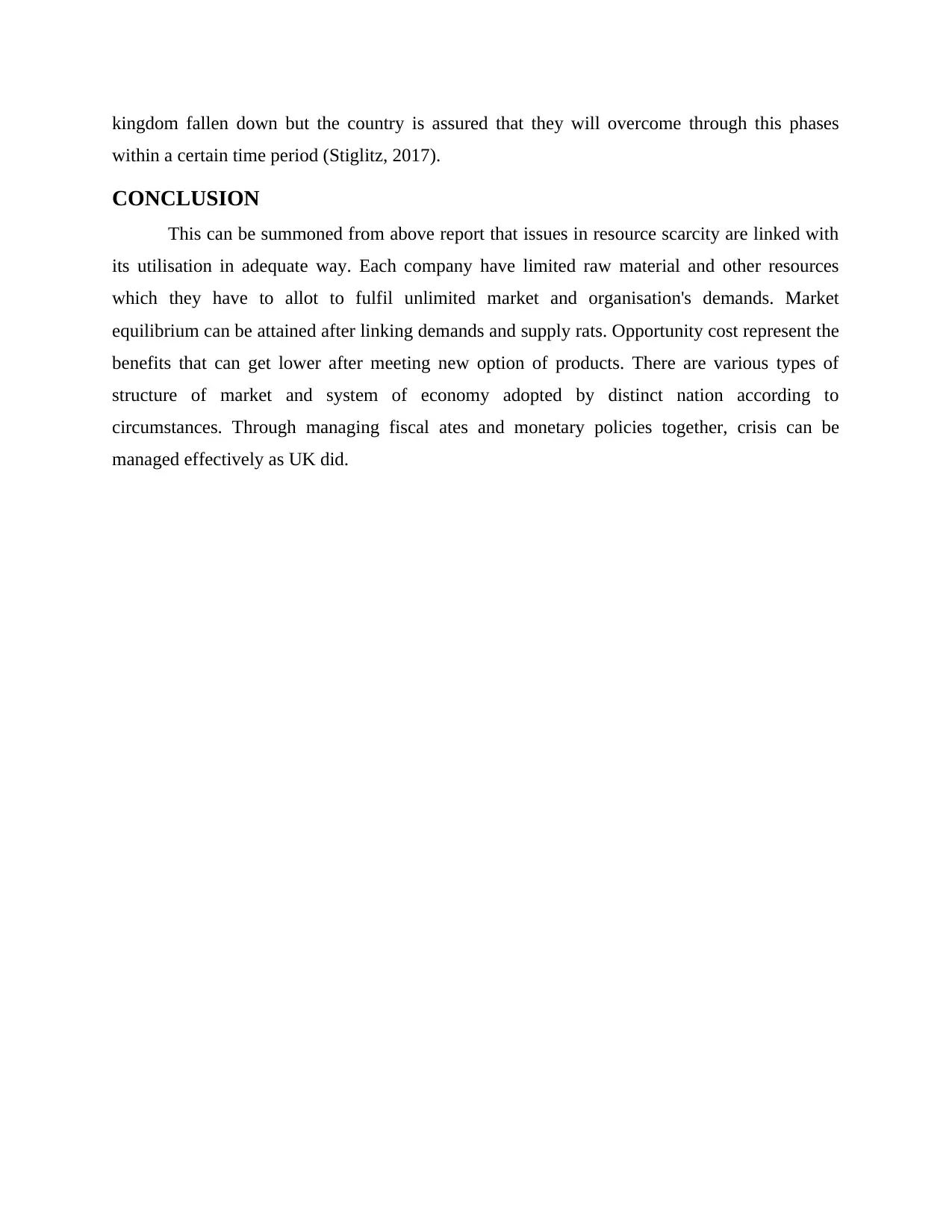
kingdom fallen down but the country is assured that they will overcome through this phases
within a certain time period (Stiglitz, 2017).
CONCLUSION
This can be summoned from above report that issues in resource scarcity are linked with
its utilisation in adequate way. Each company have limited raw material and other resources
which they have to allot to fulfil unlimited market and organisation's demands. Market
equilibrium can be attained after linking demands and supply rats. Opportunity cost represent the
benefits that can get lower after meeting new option of products. There are various types of
structure of market and system of economy adopted by distinct nation according to
circumstances. Through managing fiscal ates and monetary policies together, crisis can be
managed effectively as UK did.
within a certain time period (Stiglitz, 2017).
CONCLUSION
This can be summoned from above report that issues in resource scarcity are linked with
its utilisation in adequate way. Each company have limited raw material and other resources
which they have to allot to fulfil unlimited market and organisation's demands. Market
equilibrium can be attained after linking demands and supply rats. Opportunity cost represent the
benefits that can get lower after meeting new option of products. There are various types of
structure of market and system of economy adopted by distinct nation according to
circumstances. Through managing fiscal ates and monetary policies together, crisis can be
managed effectively as UK did.

REFERENCES
Books and Journals:
Audretsch, D. B., Kuratko, D. F. and Link, A. N., 2015. Making sense of the elusive paradigm of
entrepreneurship. Small Business Economics. 45(4). pp.703-712.
Coomer, J. C. ed., 2016. Quest for a Sustainable Society: Pergamon Policy Studies on Business
and Economics. Elsevier.
Daunfeldt, S. O. and Halvarsson, D., 2015. Are high-growth firms one-hit wonders? Evidence
from Sweden. Small Business Economics. 44(2). pp.361-383.
Ghio, N. and et. al., 2015. The emergence of the knowledge spillover theory of entrepreneurship.
Small Business Economics. 44(1). pp.1-18.
Laubach, T. and Williams, J. C., 2016. Measuring the natural rate of interest redux. Business
Economics. 51(2). pp.57-67.
Miller, D., 2015. A downside to the entrepreneurial personality?. Entrepreneurship Theory and
Practice. 39(1). pp.1-8.
Poloz, S. S., 2015. Integrating financial stability into monetary policy. Business Economics.
50(4). pp.200-205.
Rivlin, A. M., 2015. Thoughts about monetary and fiscal policy in a postinflation world.
Business Economics. 50(2). pp.51-56.
Silvia, J. and Iqbal, A., 2015. An ordered probit approach to predicting the probability of
inflation/deflation. Business Economics. 50(1). pp.12-19.
Simar, L., 2015. Applied multivariate statistical analysis. Springer Berlin Heidelberg: Imprint:
Springer,.
Stiglitz, J. E., 2017. The overselling of globalization. Business Economics. 52(3). pp.129-137.
Taylor, J. B. and Wieland, V., 2016. Finding the equilibrium real interest rate in a fog of policy
deviations. Business Economics. 51(3). pp.147-154.
Vismara, S., 2016. Equity retention and social network theory in equity crowdfunding. Small
Business Economics. 46(4). pp.579-590.
Williams, J. C., 2015. The decline in the natural rate of interest. Business Economics. 50(2).
pp.57-60.
Online:
Introduction to economics: Macroeconomics. 2017. [Online]. Available through:
<https://www.edx.org/course/introduction-economics-macroeconomics-snux-snu044-
088-2x-0>.
Microeconomics. 2017. [Online]. Available through:
<https://www.khanacademy.org/economics-finance-domain/microeconomics>.
12
Books and Journals:
Audretsch, D. B., Kuratko, D. F. and Link, A. N., 2015. Making sense of the elusive paradigm of
entrepreneurship. Small Business Economics. 45(4). pp.703-712.
Coomer, J. C. ed., 2016. Quest for a Sustainable Society: Pergamon Policy Studies on Business
and Economics. Elsevier.
Daunfeldt, S. O. and Halvarsson, D., 2015. Are high-growth firms one-hit wonders? Evidence
from Sweden. Small Business Economics. 44(2). pp.361-383.
Ghio, N. and et. al., 2015. The emergence of the knowledge spillover theory of entrepreneurship.
Small Business Economics. 44(1). pp.1-18.
Laubach, T. and Williams, J. C., 2016. Measuring the natural rate of interest redux. Business
Economics. 51(2). pp.57-67.
Miller, D., 2015. A downside to the entrepreneurial personality?. Entrepreneurship Theory and
Practice. 39(1). pp.1-8.
Poloz, S. S., 2015. Integrating financial stability into monetary policy. Business Economics.
50(4). pp.200-205.
Rivlin, A. M., 2015. Thoughts about monetary and fiscal policy in a postinflation world.
Business Economics. 50(2). pp.51-56.
Silvia, J. and Iqbal, A., 2015. An ordered probit approach to predicting the probability of
inflation/deflation. Business Economics. 50(1). pp.12-19.
Simar, L., 2015. Applied multivariate statistical analysis. Springer Berlin Heidelberg: Imprint:
Springer,.
Stiglitz, J. E., 2017. The overselling of globalization. Business Economics. 52(3). pp.129-137.
Taylor, J. B. and Wieland, V., 2016. Finding the equilibrium real interest rate in a fog of policy
deviations. Business Economics. 51(3). pp.147-154.
Vismara, S., 2016. Equity retention and social network theory in equity crowdfunding. Small
Business Economics. 46(4). pp.579-590.
Williams, J. C., 2015. The decline in the natural rate of interest. Business Economics. 50(2).
pp.57-60.
Online:
Introduction to economics: Macroeconomics. 2017. [Online]. Available through:
<https://www.edx.org/course/introduction-economics-macroeconomics-snux-snu044-
088-2x-0>.
Microeconomics. 2017. [Online]. Available through:
<https://www.khanacademy.org/economics-finance-domain/microeconomics>.
12
⊘ This is a preview!⊘
Do you want full access?
Subscribe today to unlock all pages.

Trusted by 1+ million students worldwide
1 out of 12
Related Documents
Your All-in-One AI-Powered Toolkit for Academic Success.
+13062052269
info@desklib.com
Available 24*7 on WhatsApp / Email
![[object Object]](/_next/static/media/star-bottom.7253800d.svg)
Unlock your academic potential
Copyright © 2020–2025 A2Z Services. All Rights Reserved. Developed and managed by ZUCOL.





